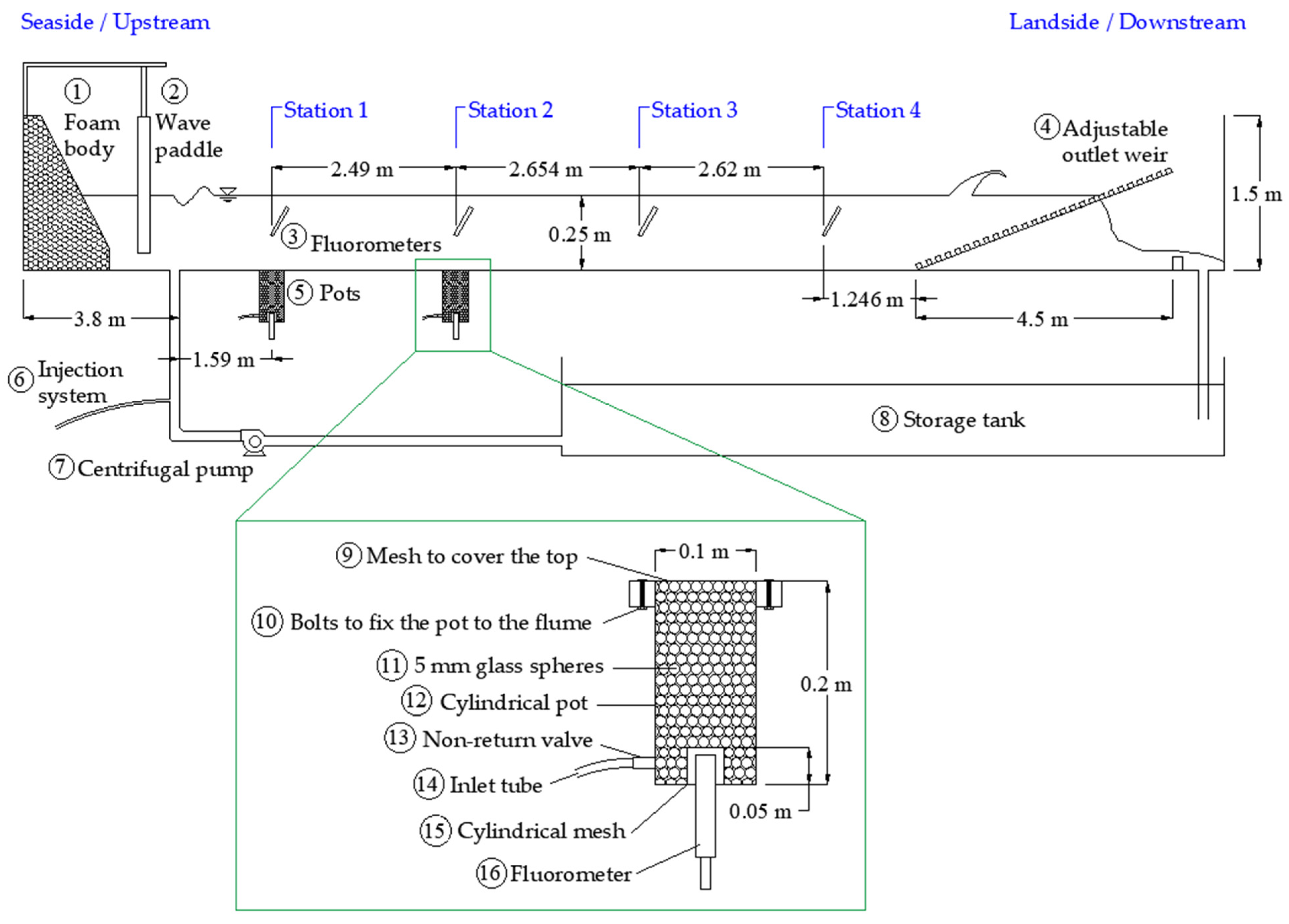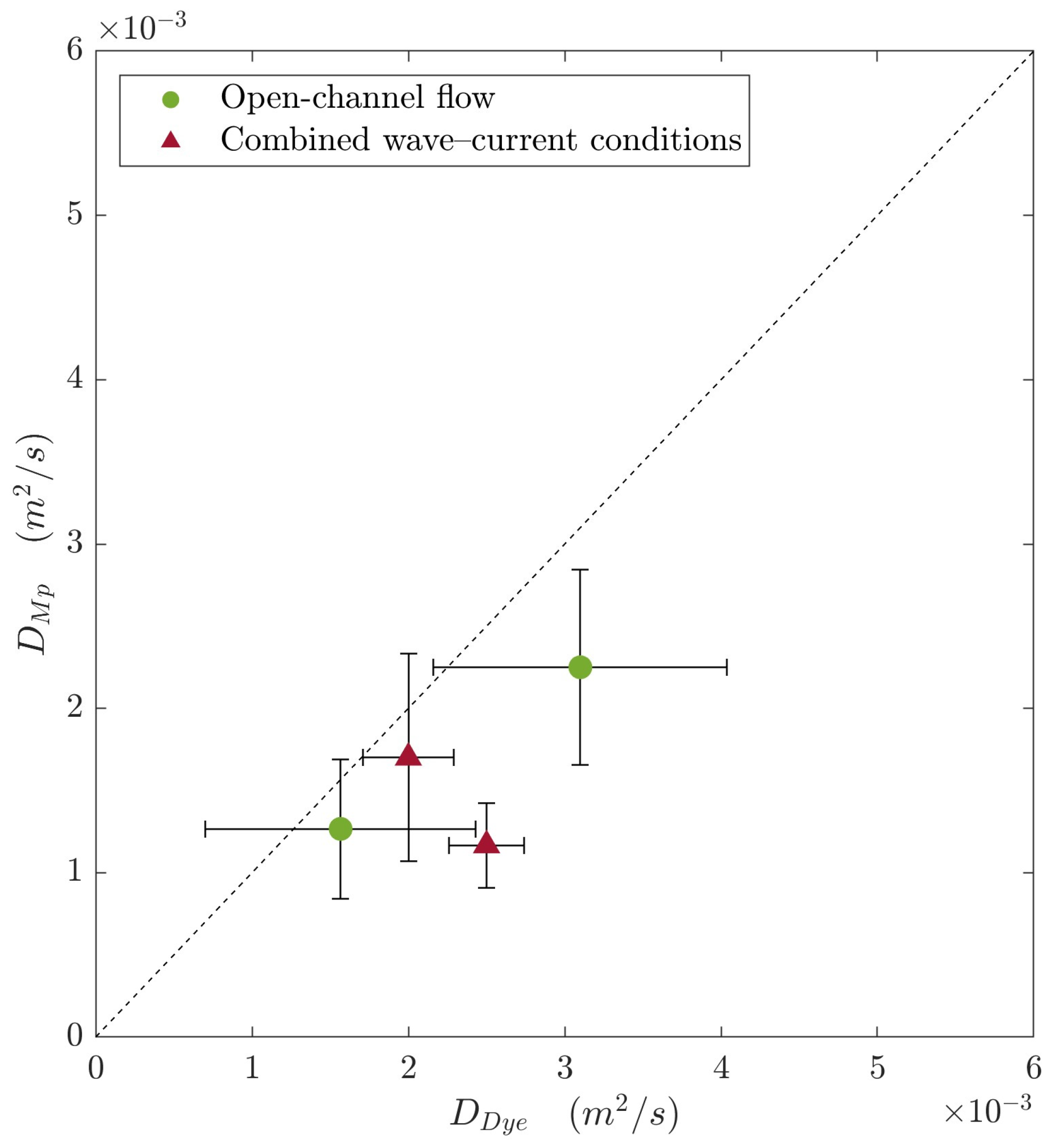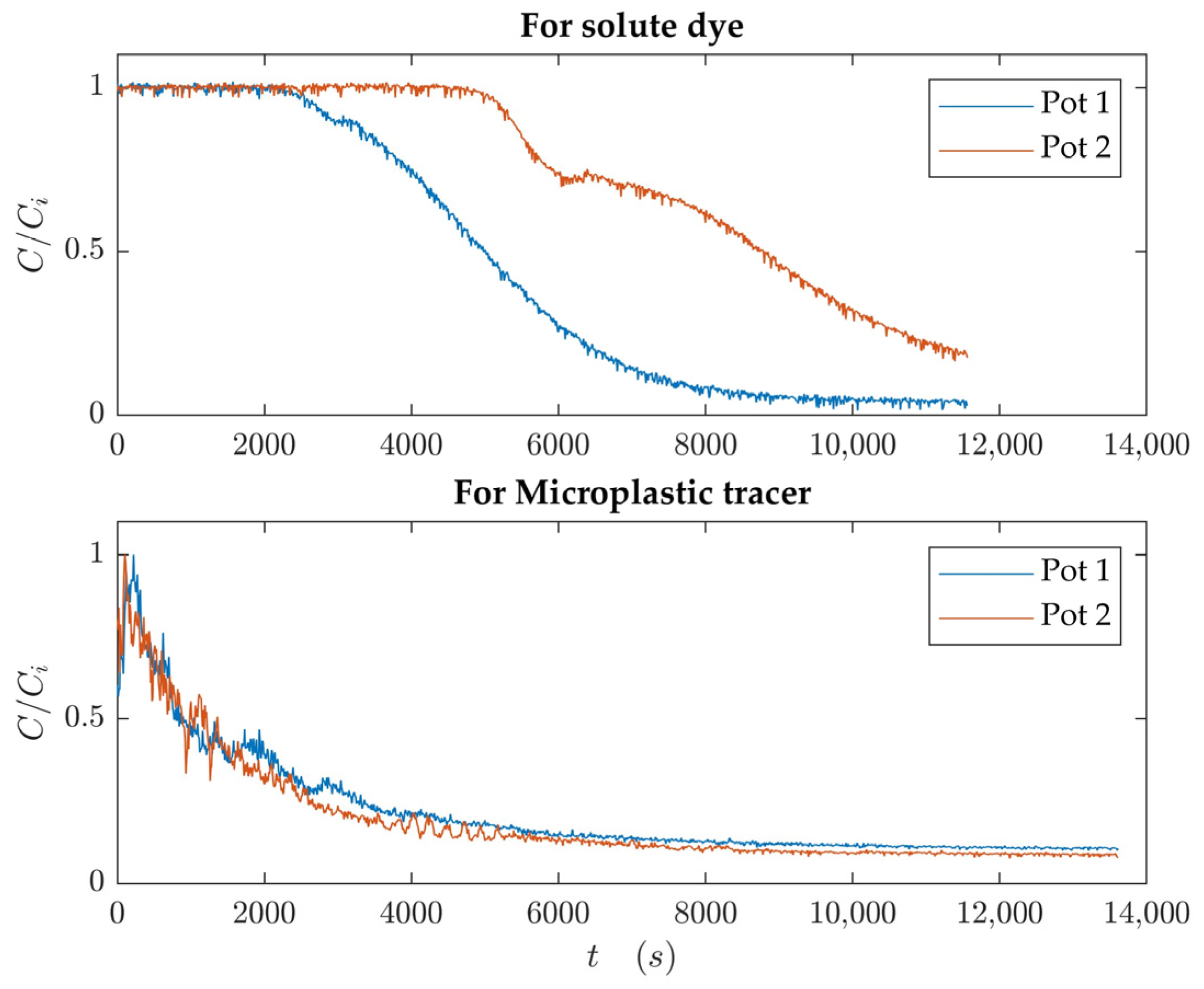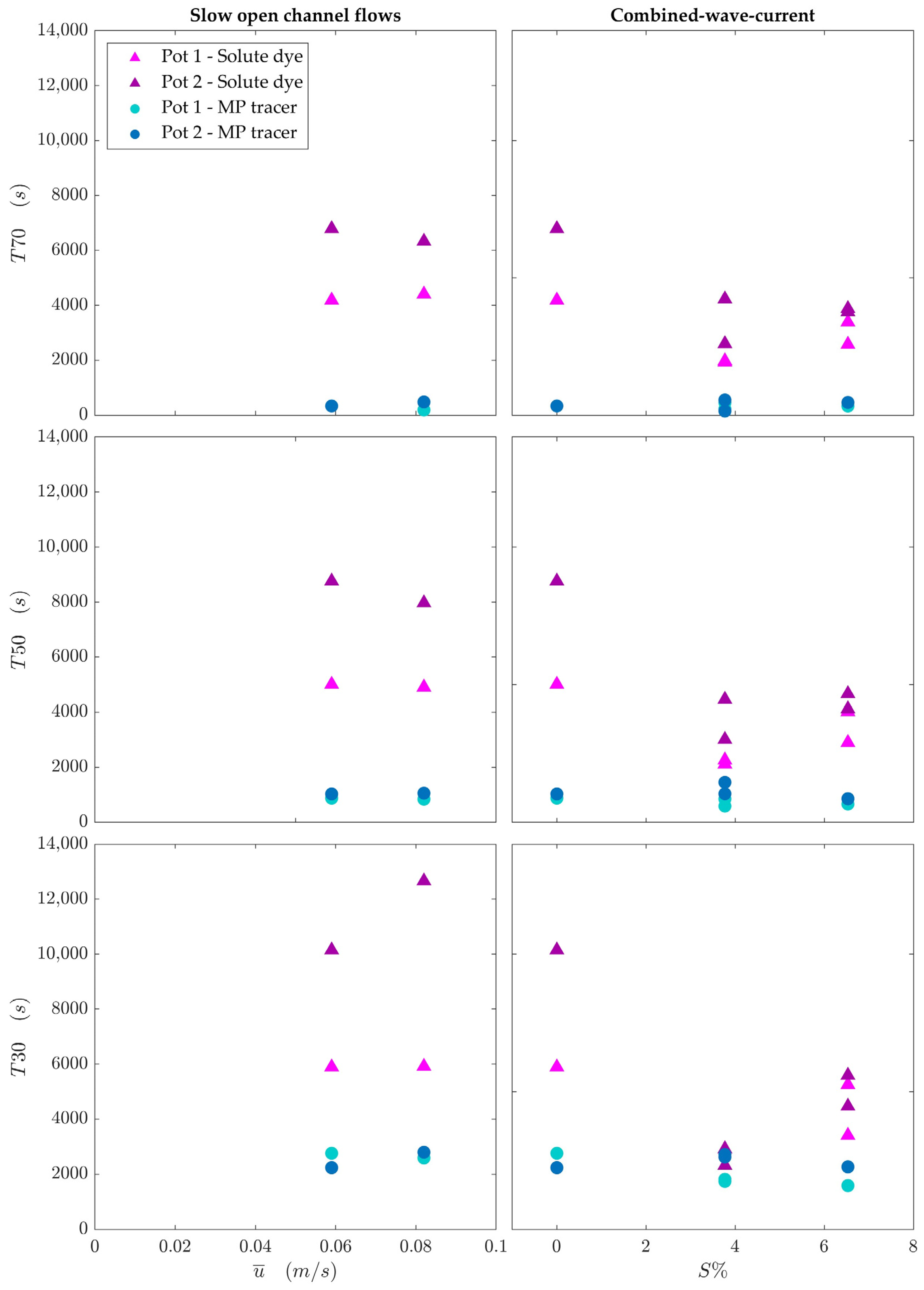Longitudinal Dispersion and Hyporheic Exchange of Neutrally Buoyant Microplastics in the Presence of Waves and Currents
Abstract
:1. Introduction
2. Theoretical Background
2.1. Longitudinal Dispersion Coefficient
2.2. Mixing in Porous Sediments across the Hyporheic Zone
3. Methodology
3.1. Types of Tracers, Instrumentation, and Calibration
3.2. Longitudinal Dispersion Measurements
3.3. Measuring Mixing across the Hyporheic Zone
3.4. Test Conditions
4. Results and Discussion
4.1. Longitudinal Dispersion
4.2. Mixing across the Hyporheic Zone
5. Conclusions
Author Contributions
Funding
Institutional Review Board Statement
Informed Consent Statement
Data Availability Statement
Conflicts of Interest
Nomenclature
| concentration (ML−3) | |
| initial concentration (ML−3) | |
| geometric mean particle diameter of the bed sediment (L) | |
| dispersion coefficient (L2T−1) | |
| dispersion coefficient of the solute dye (L2T−1) | |
| effective interface exchange coefficient (L2T−1) | |
| vertical diffusion coefficient inside the sediment bed (L2T−1) | |
| molecular diffusion coefficient in sediment pore water (L2T−1) | |
| dispersion coefficient of the microplastic tracer (L2T−1) | |
| depth of the flow (L) | |
| wave height (L) | |
| diffusive flux, i.e., mass transport rate per unit width per unit time (ML−1T−1) | |
| flow rate (L3/T) | |
| wave steepness (%) | |
| wave period (T) | |
| time to reach 70% of the initial concentration (T) | |
| time to reach 50% of the initial concentration (T) | |
| time to reach 30% of the initial concentration (T) | |
| time to reach 70% of the initial dye concentration (T) | |
| time to reach 50% of the initial dye concentration (T) | |
| time to reach 30% of the initial dye concentration (T) | |
| time to reach 70% of the initial microplastic tracer concentration (T) | |
| time to reach 50% of the initial microplastic tracer concentration (T) | |
| time to reach 30% of the initial microplastic tracer concentration (T) | |
| Depth-averaged flow velocity (LT−1) | |
| bed shear velocity (LT−1) | |
| coordinates in the streamwise direction (L) | |
| coordinates in the lateral direction across the flow (L) | |
| coordinates in the vertical direction—positive upwards (L) | |
| bed shear stress (ML−1T−2) | |
| fluid density (ML−3) | |
| temporal variance of the tracer concentration time series (T2) |
References
- Frias, J.; Nash, R. Microplastics: Finding a consensus on the definition. Mar. Pollut. Bull. 2018, 138, 145–147. [Google Scholar] [CrossRef] [PubMed]
- Alimi, O.S.; Farner Budarz, J.; Hernandez, L.M.; Tufenkji, N. Microplastics and Nanoplastics in Aquatic Environments: Aggregation, Deposition, and Enhanced Contaminant Transport. Environ. Sci. Technol. 2018, 52, 1704–1724. [Google Scholar] [CrossRef] [PubMed]
- Derraik, J.G.B. The pollution of the marine environment by plastic debris: A review. Mar. Pollut. Bull. 2002, 44, 842–852. [Google Scholar] [CrossRef] [PubMed]
- Chang, M. Reducing microplastics from facial exfoliating cleansers in wastewater through treatment versus consumer product decisions. Mar. Pollut. Bull. 2015, 101, 330–333. [Google Scholar] [CrossRef]
- Sharma, S.; Chatterjee, S. Microplastic pollution, a threat to marine ecosystem and human health: A short review. Environ. Sci. Pollut. Res. 2017, 24, 21530–21547. [Google Scholar] [CrossRef]
- Hu, Y.; Gong, M.; Wang, J.; Bassi, A. Current research trends on microplastic pollution from wastewater systems: A critical review. Rev. Environ. Sci. Bio/Technol. 2019, 18, 207–230. [Google Scholar] [CrossRef]
- Uurasjärvi, E.; Hartikainen, S.; Setälä, O.; Lehtiniemi, M.; Koistinen, A. Microplastic concentrations, size distribution, and polymer types in the surface waters of a northern European lake. Water Environ. Res. 2019, 92, 149–156. [Google Scholar] [CrossRef]
- Coyle, R.; Hardiman, G.; Driscoll, K.O. Microplastics in the marine environment: A review of their sources, distribution processes, uptake and exchange in ecosystems. Case Stud. Chem. Environ. Eng. 2020, 2, 100010. [Google Scholar] [CrossRef]
- Eriksen, M.; Lebreton, L.C.M.; Carson, H.S.; Thiel, M.; Moore, C.J.; Borerro, J.C.; Galgani, F.; Ryan, P.G.; Reisser, J. Plastic Pollution in the World’s Oceans: More than 5 Trillion Plastic Pieces Weighing over 250,000 Tons Afloat at Sea. PLoS ONE 2014, 9, e111913. [Google Scholar] [CrossRef]
- Woodall, L.C.; Sanchez-Vidal, A.; Canals, M.; Paterson, G.L.J.; Coppock, R.; Sleight, V.; Calafat, A.; Rogers, A.D.; Narayanaswamy, B.E.; Thompson, R.C. The deep sea is a major sink for microplastic debris. R. Soc. Open Sci. 2014, 1, 140317. [Google Scholar] [CrossRef]
- Browne, M.A.; Galloway, T.S.; Thompson, R.C. Spatial Patterns of Plastic Debris along Estuarine Shorelines. Environ. Sci. Technol. 2010, 44, 3404–3409. [Google Scholar] [CrossRef] [PubMed]
- Jamieson, A.J.; Brooks, L.S.R.; Reid, W.D.K.; Piertney, S.B.; Narayanaswamy, B.E.; Linley, T.D. Microplastics and synthetic particles ingested by deep-sea amphipods in six of the deepest marine ecosystems on Earth. R. Soc. Open Sci. 2019, 6, 180667. [Google Scholar] [CrossRef] [PubMed]
- Mato, Y.; Isobe, T.; Takada, H.; Kanehiro, H.; Ohtake, C.; Kaminuma, T. Plastic Resin Pellets as a Transport Medium for Toxic Chemicals in the Marine Environment. Environ. Sci. Technol. 2000, 35, 318–324. [Google Scholar] [CrossRef] [PubMed]
- Taylor, M.L.; Gwinnett, C.; Robinson, L.F.; Woodall, L.C. Plastic microfibre ingestion by deep-sea organisms. Sci. Rep. 2016, 6, 33997. [Google Scholar] [CrossRef]
- Wu, H.; Hou, J.; Wang, X. A review of microplastic pollution in aquaculture: Sources, effects, removal strategies and prospects. Ecotoxicol. Environ. Saf. 2023, 252, 114567. [Google Scholar] [CrossRef]
- Jain, R.; Gaur, A.; Suravajhala, R.; Chauhan, U.; Pant, M.; Tripathi, V.; Pant, G. Microplastic pollution: Understanding microbial degradation and strategies for pollutant reduction. Sci. Total. Environ. 2023, 905, 167098. [Google Scholar] [CrossRef]
- James, I. Modelling pollution dispersion, the ecosystem and water quality in coastal waters: A review. Environ. Model. Softw. 2002, 17, 363–385. [Google Scholar] [CrossRef]
- Chen, Y.; Zeng, L. A holistic model for microplastic dispersion in a free-surface wetland flow. J. Clean. Prod. 2024, 449. [Google Scholar] [CrossRef]
- Rowlands, E.; Galloway, T.; Cole, M.; Peck, V.L.; Posacka, A.; Thorpe, S.; Manno, C. Vertical flux of microplastic, a case study in the Southern Ocean, South Georgia. Mar. Pollut. Bull. 2023, 193, 115117. [Google Scholar] [CrossRef]
- Wagner, M.; Lambert, S. (Eds.) Freshwater Microplastics; Springer Nature: Dordrecht, The Netherlands, 2018; Volume 58. [Google Scholar] [CrossRef]
- Okamura, T. Polyethylene (PE.; Low Density and High Density). In Encyclopedia of Polymeric Nanomaterials; Springer: Berlin/Heidelberg, Germany, 2015; pp. 1826–1829. [Google Scholar] [CrossRef]
- Lavers, J.L.; Oppel, S.; Bond, A.L. Factors influencing the detection of beach plastic debris. Mar. Environ. Res. 2016, 119, 245–251. [Google Scholar] [CrossRef]
- Erni-Cassola, G.; Gibson, M.I.; Thompson, R.C.; Christie-Oleza, J.A. Lost, but Found with Nile Red: A Novel Method for Detecting and Quantifying Small Microplastics (1 mm to 20 μm) in Environmental Samples. Environ. Sci. Technol. 2017, 51, 13641–13648. [Google Scholar] [CrossRef] [PubMed]
- Cook, S.; Chan, H.-L.; Abolfathi, S.; Bending, G.D.; Schäfer, H.; Pearson, J.M. Longitudinal dispersion of microplastics in aquatic flows using fluorometric techniques. Water Res. 2020, 170, 115337. [Google Scholar] [CrossRef] [PubMed]
- Filippi, M.; Hanlon, R.; Rypina, I.I.; Hodges, B.A.; Peacock, T.; Schmale, D.G. Tracking a Surrogate Hazardous Agent (Rhodamine Dye) in a Coastal Ocean Environment Using In Situ Measurements and Concentration Estimates Derived from Drone Images. Remote. Sens. 2021, 13, 4415. [Google Scholar] [CrossRef]
- Stride, B.; Stride, B.; Abolfathi, S.; Abolfathi, S.; Odara, M.G.N.; Odara, M.G.N.; Bending, G.D.; Bending, G.D.; Pearson, J.; Pearson, J. Modeling Microplastic and Solute Transport in Vegetated Flows. Water Resour. Res. 2023, 59. [Google Scholar] [CrossRef]
- Stride, B.; Abolfathi, S.; Bending, G.D.; Pearson, J. Quantifying microplastic dispersion due to density effects. J. Hazard. Mater. 2024, 466, 133440. [Google Scholar] [CrossRef]
- Fick, A.V. On liquid diffusion. Lond. Edinb. Dublin Philos. Mag. J. Sci. 1855, 10, 30–39. [Google Scholar] [CrossRef]
- Elder, J.W. The dispersion of marked fluid in turbulent shear flow. J. Fluid Mech. 1959, 5, 544–560. [Google Scholar] [CrossRef]
- Fischer, H.B.; List, E.J.; Koh, R.C.Y.; Imberger, J.; Brooks, N.H. Chapter 2: Fickian Diffusion. In Mixing in Inland and Coastal Waters, 1st ed.; Academic Press: Amsterdam, The Netherlands, 1979; Chapter 2; pp. 30–50. [Google Scholar]
- Chandler, I.D.; Guymer, I.; Pearson, J.M.; van Egmond, R. Vertical variation of mixing within porous sediment beds below turbulent flows. Water Resour. Res. 2016, 52, 3493–3509. [Google Scholar] [CrossRef]
- Stern, D.A.; Khanbilvardi, R.; Alair, J.C.; Richardson, W. Description of flow through a natural wetland using dye tracer tests. Ecol. Eng. 2001, 18, 173–184. [Google Scholar] [CrossRef]
- Law, K.L. Plastics in the Marine Environment. Annu. Rev. Mar. Sci. 2017, 9, 205–229. [Google Scholar] [CrossRef]
- Clark, L.K.; DiBenedetto, M.H.; Ouellette, N.T.; Koseff, J.R. Dispersion of finite-size, non-spherical particles by waves and currents. J. Fluid Mech. 2022, 954, A3. [Google Scholar] [CrossRef]
- Chubarenko, I.; Bagaev, A.; Zobkov, M.; Esiukova, E. On some physical and dynamical properties of microplastic particles in marine environment. Mar. Pollut. Bull. 2016, 108, 105–112. [Google Scholar] [CrossRef]






| Flow Rate (Q) (L/s) | Hydrodynamic Condition | Depth-Averaged Velocity () (m/s) | Input Wave Height (H) (m) | Input Wave Period (T) (s) | Input Wave Steepness (S) (%) |
|---|---|---|---|---|---|
| 5 | Unidirectional flow | 0.059 | N/A | N/A | N/A |
| 5 | Wave–current combined | 0.059 | 0.1 | 1.79 | 3.77% |
| 5 | Wave–current combined | 0.059 | 0.1 | 1.13 | 6.53% |
| 7 | Unidirectional flow | 0.082 | N/A | N/A | N/A |
| Flow Rate () (L/s) | Hydrodynamic Condition | Input Wave Steepness (S) (%) | Longitudinal Dispersion Coefficients (D) (m2/s) × 10−2 | ||
|---|---|---|---|---|---|
| Solute | Microplastics | ||||
| 5 | Unidirectional flow | N/A | Repeat 1 | 0.17 | 0.15 |
| Repeat 2 | 0.20 | 0.13 | |||
| Repeat 3 | 0.10 | 0.10 | |||
| Average | 0.16 | 0.13 | |||
| 5 | Wave–current combined | 3.77% | Repeat 1 | 0.18 | 0.18 |
| Repeat 2 | 0.21 | 0.16 | |||
| Repeat 3 | 0.21 | - | |||
| Average | 0.20 | 0.17 | |||
| 5 | Wave–current combined | 6.53% | Repeat 1 | 0.24 | 0.12 |
| Repeat 2 | 0.26 | 0.11 | |||
| Repeat 3 | - | 0.12 | |||
| Average | 0.25 | 0.12 | |||
| 7 | Unidirectional flow | N/A | Repeat 1 | 0.32 | 0.20 |
| Repeat 2 | 0.25 | 0.25 | |||
| Repeat 3 | 0.36 | - | |||
| Average | 0.31 | 0.23 | |||
| Flow Rate (Q) (L/s) | Scenario | Input Wave Steepness (S) (%) | |||
|---|---|---|---|---|---|
| 5 | Open channel flow | N/A | 16.48 | 7.23 | 3.21 |
| 5 | Combined wave–current | 3.77% | 6.61 | 2.69 | 1.43 |
| 5 | Combined wave–current | 6.53% | 15.83 | 10.27 | 4.77 |
| 7 | Open channel flow | N/A | 16.17 | 6.79 | 6.91 |
Disclaimer/Publisher’s Note: The statements, opinions and data contained in all publications are solely those of the individual author(s) and contributor(s) and not of MDPI and/or the editor(s). MDPI and/or the editor(s) disclaim responsibility for any injury to people or property resulting from any ideas, methods, instructions or products referred to in the content. |
© 2024 by the authors. Licensee MDPI, Basel, Switzerland. This article is an open access article distributed under the terms and conditions of the Creative Commons Attribution (CC BY) license (https://creativecommons.org/licenses/by/4.0/).
Share and Cite
Nipuni Odara, M.G.; Waghajiani, D.; Obersterescu, G.-C.; Pearson, J. Longitudinal Dispersion and Hyporheic Exchange of Neutrally Buoyant Microplastics in the Presence of Waves and Currents. Microplastics 2024, 3, 503-517. https://doi.org/10.3390/microplastics3030032
Nipuni Odara MG, Waghajiani D, Obersterescu G-C, Pearson J. Longitudinal Dispersion and Hyporheic Exchange of Neutrally Buoyant Microplastics in the Presence of Waves and Currents. Microplastics. 2024; 3(3):503-517. https://doi.org/10.3390/microplastics3030032
Chicago/Turabian StyleNipuni Odara, Merenchi Galappaththige, Devvan Waghajiani, George-Catalin Obersterescu, and Jonathan Pearson. 2024. "Longitudinal Dispersion and Hyporheic Exchange of Neutrally Buoyant Microplastics in the Presence of Waves and Currents" Microplastics 3, no. 3: 503-517. https://doi.org/10.3390/microplastics3030032
APA StyleNipuni Odara, M. G., Waghajiani, D., Obersterescu, G.-C., & Pearson, J. (2024). Longitudinal Dispersion and Hyporheic Exchange of Neutrally Buoyant Microplastics in the Presence of Waves and Currents. Microplastics, 3(3), 503-517. https://doi.org/10.3390/microplastics3030032






